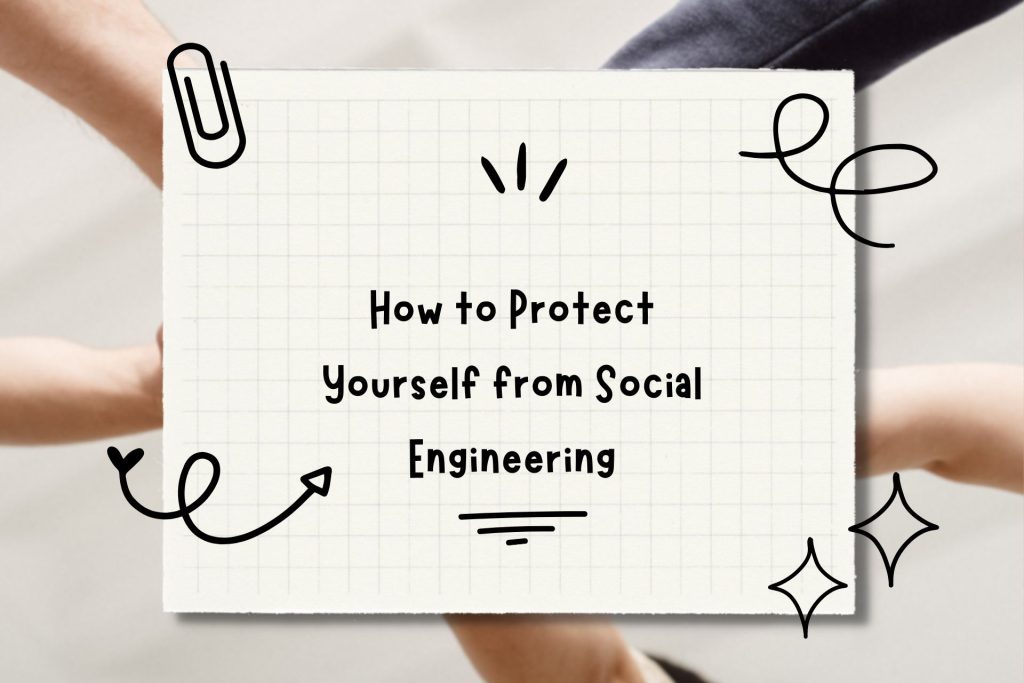When it comes to protecting yourself from social engineering attacks, awareness is key. Cybercriminals are constantly coming up with new tricks, but if you know what to look out for, you can stay one step ahead.
Phishing, pretexting, baiting, quid pro quo, and tailgating are the five common tactics used by cybercriminals in social engineering attacks. Phishing, in particular, is a sneaky one, where cybercriminals send emails or text messages that look totally legit, but are actually designed to trick you into clicking on a harmful link or downloading malware.
Pretexting involves creating a false scenario to gain your trust, like pretending to be from IT support to get your login details. Baiting is when they dangle something enticing, like a free USB drive, to get you to download malware.
Quid pro quo involves offering a benefit in exchange for sensitive information, such as promising a gift card in exchange for login credentials.
And tailgating? That’s when someone sneaks into a restricted area by following someone else without permission.
To stay safe, always verify the identity of the person or organization before sharing sensitive information or taking any actions.
Be wary of unsolicited emails, texts, or calls, and never click on links or download attachments from unknown sources. Keep your software and security systems up to date, use strong passwords, and consider two-factor authentication for an extra layer of protection.
Stay sharp out there, and don’t let those cyber tricksters catch you off guard!
What is Social Engineering?

Social engineering is a type of cyber attack that involves manipulating people into divulging confidential information or performing actions that may not be in their best interest.
Social engineers use psychological tricks and deception to gain access to sensitive data, systems, or networks. Understanding social engineering is essential to prevent falling victim to these attacks.
Types of Social Engineering Attacks
There are several types of social engineering attacks, including phishing, pretexting, baiting, quid pro quo, and tailgating.
- Phishing is the most common type of social engineering attack, where attackers use emails or messages that appear to be from a legitimate source to trick users into clicking on malicious links or downloading malware.
- Pretexting involves creating a fake scenario to gain access to sensitive information, such as pretending to be a bank representative or IT support personnel.
- Baiting involves offering something enticing to lure the victim into clicking on a malicious link or downloading malware.
- Quid pro quo involves offering something in exchange for sensitive information, such as promising a free gift card in exchange for login credentials.
- Tailgating involves following someone into a restricted area without proper authorization.
Common Tactics Used by Social Engineers
Social engineers use several tactics to manipulate their victims, including urgency, authority, familiarity, and curiosity.
Urgency involves creating a sense of urgency to force the victim into making a hasty decision, such as threatening to shut down their account.
- Authority involves pretending to be someone in authority, such as an IT support personnel or a law enforcement officer, to gain the victim’s trust.
- Familiarity involves pretending to be someone the victim knows or trusts, such as a friend or a colleague, to gain access to sensitive information.
- Curiosity involves offering something intriguing or exciting to pique the victim’s curiosity, such as a fake job offer or a lottery win.
To protect yourself from social engineering attacks, it is essential to be aware of these tactics and to exercise caution when dealing with unsolicited messages or requests for sensitive information.
Always verify the identity of the person or organization before sharing any confidential information, and never click on links or download attachments from unknown sources.
Best Practices for Personal Security
1. Strong Password Policies
One of the most important aspects of personal security is having strong passwords. A strong password should be at least 12 characters long and include a mix of uppercase and lowercase letters, numbers, and symbols. Avoid using common words or phrases, and never reuse passwords across multiple accounts. Additionally, consider using a password manager to generate and store unique passwords for each account.
2. Two-Factor Authentication
Two-factor authentication (2FA) adds an extra layer of security to your accounts by requiring a secondary form of verification in addition to your password. This can include a code sent to your phone or email, a fingerprint scan, or a physical security key. Enabling 2FA on all of your accounts can significantly reduce the risk of unauthorized access.
3. Regular Software Updates
Keeping your software up to date is crucial for maintaining the security of your devices. Software updates often include important security patches that address vulnerabilities and prevent attackers from exploiting them. Set your devices to automatically install updates, and be sure to update all of your apps and programs regularly.
Awareness and Training
Protecting yourself from social engineering requires a combination of technical measures and human vigilance. One of the most effective ways to prevent social engineering attacks is to raise awareness and provide training to employees.
Recognizing Phishing Attempts
Phishing is a type of social engineering attack that uses email or other forms of electronic communication to trick individuals into divulging sensitive information. It is essential to recognize phishing attempts and avoid falling prey to them.
To recognize phishing attempts, you should look out for the following signs:
- Suspicious sender: Check the sender’s email address carefully. If it looks suspicious, do not click on any links or download any attachments.
- Urgent or threatening tone: Phishing emails often use urgent or threatening language to get you to act quickly without thinking.
- Unexpected requests: Be wary of emails that ask you to provide sensitive information or perform an action that you were not expecting.
- Poor grammar and spelling: Phishing emails often contain grammatical errors and spelling mistakes.
Security Awareness Programs
Security awareness programs can help employees understand social engineering tactics and how to avoid them. These programs can include training sessions, workshops, and online courses.
Security awareness programs should cover the following topics:
- Basic security hygiene: Employees should be trained on basic security hygiene practices such as creating strong passwords, keeping software up to date, and avoiding public Wi-Fi networks.
- Social engineering tactics: Employees should be aware of the different types of social engineering tactics, including phishing, pretexting, and baiting.
- Reporting incidents: Employees should know how to report security incidents and who to contact in case of a security breach.
Physical Security Measures
Protecting yourself from social engineering attacks also involves implementing physical security measures. These measures include securing your workspace and implementing visitor management systems.
Secure Workspace Protocols
To secure your workspace, you need to ensure that only authorized personnel have access to it. This means securing your office with locks and access control systems. You should also ensure that sensitive documents and information are stored in locked cabinets or safes.
It is also important to establish clear protocols for handling sensitive information. You should define who has access to what information and under what circumstances. You should also establish procedures for handling and disposing of sensitive information.
Visitor Management Systems
Implementing visitor management systems can help prevent unauthorized access to your workspace. These systems typically involve requiring visitors to sign in and provide identification before being allowed access to your office.
You can also implement security measures such as security cameras and alarms to monitor your workspace. This can help deter unauthorized access and provide evidence in the event of a security breach.
Incident Response and Reporting
Developing an Incident Response Plan
Having a well-defined incident response plan is essential to protecting yourself from social engineering attacks. Your incident response plan should include the following:
- Identification of potential incidents
- Steps to contain the incident
- Procedures for investigating the incident
- Steps to recover from the incident
- Procedures for reporting the incident
Your incident response plan should be regularly reviewed and updated to ensure that it is effective and up-to-date.
Reporting Procedures
Reporting incidents is an essential part of protecting yourself from social engineering attacks. If you believe that you have been the victim of a social engineering attack, you should report it immediately. Reporting incidents can help to prevent further attacks and can also help to identify the perpetrators.
When reporting incidents, you should follow these procedures:
- Report the incident to your organization’s security team or IT department
- Provide as much detail as possible about the incident, including the date, time, and location of the incident, as well as any relevant information about the attacker
- Do not attempt to investigate the incident on your own, as this could compromise the investigation and potentially make the situation worse
When you incorporate these measures, you can play a crucial role in safeguarding both yourself and your organization from the perils of social engineering attacks.






